Efficient and targeted information supply for members of santésuisse
Prior to integration of the E-Business solution, santésuisse, as the Trade Association of Swiss Health Insurers, embodied the typical characteristics of a stolid association apparatus. In order to meet its information mandate in the Swiss healthcare and medical insurance sector, the association now relies on E-Business technologies. An accompanying image improvement could be chalked up through the E-Business integration as a positive additional effect and a cost-effective, efficient and above all targeted supply of information to members of the association could be achieved.
Inhaltsverzeichnis
1. The association2. E-Business strategy
3. Integration solution
Business perspective, process view, newsletter, push concept, application view, solution architecture, XML round trip
4. Implementation
5. Operation
Maintenance, costs, benefits and profitability, running costs, investments
6. Success factors and difficulties
1. The association
santésuisse, as the operator of the E-Business solution, is the Trade Association of Swiss Health Insurers. As such, it safeguards the interests of its members (all health insurers in Switzerland) by representing them with respect to the Swiss authorities or, via its administrative offices, with respect to the cantonal authorities. santésuisse also supports a targeted cooperation with the organisations and institutions involved in the healthcare sector in order to therefore develop joint solution approaches in the healthcare sector. As a trade association, santésuisse promotes understanding for health insurers in politics and in the public sector. It formulates and represents the position of members with regard to welfare and health policy issues and on social issues. The aim of the association is, on the one hand, to establish a positive image of Swiss health insurers in society and, on the other hand, to fulfil its information mandate. This information mandate refers to both the provision of information for members of the association (e.g. contracts with hospitals) and for the interested public (e.g. items regarding KVG revision).
Background:
santésuisse originated from the Concordat of Swiss Health Insurers (KSK), whose foundation stone was laid in 1891 as the Free Association of the Zurich, Thurgau and St. Gallen/Appenzell Health Insurance Associations. In 1914, the first regulations for health insurance companies covering the whole of Switzerland were established when the Health and Accident Insurance Law (KUVG) came into force. With the appointment of the first, full-time concordat secretary in 1924, the break with the previously practiced suburban system was completed. A subsequent revision of the KUVG resulted in the separation of accident insurance and brought about the Health Insurance Law (KVG). An umbrella association of all health insurance companies covering the whole of Switzerland was not created until the merger with Fédération romande und Federazione ticinese in 1985. Following the merger with the cantonal associations, this organisation has operated since 2002 as the association of heatlh insurers for the whole of Switzerland under the name santésuisse
The structure of the association is subdivided according to four regions and departments. The generall assembly of health insurers proposes the executive council (currently 14 members), which appoints the board of santésuisse. The board in turn has the authority to supervise the directives of the regions and departments. The four regions of santésuisse divide Switzerland into the areas West, Centre, East I and East II. The departments for economics and law, politics and communication, tariffs and prices, services and resources and logistics are spread over all these regions (matrix organisation).
Industry sector, product and target group:
santésuisse operates as an association in the healthcare sector and in this case especially in the health insurance sector. As this association is not a profit-oriented company, the development of market potential plays quite a minor role. santésuisse can be understood as a service provider whose central function is the supply of information to members and interested groups of people. Interested parties such as those from the following groups are approached as target groups: media, politics, members (health insurers), internal personnel, students (e.g. enquiries for dissertations on the healthcare system in Switzerland) and teachers (e.g. access to graphics and statistic database). The supply of information is guaranteed via the internet and a specially developed extranet, which can only be accessed by members. The interested parties can call up information about all areas and issues relating to healthcare via the internet (cf. Fig. 1.1).
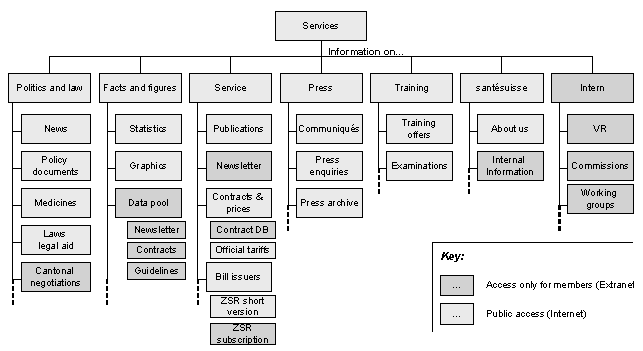
Fig. 1.1: Services of santésuisse
In the field of politics and law, the current discussion points in the healthware sector (news) can be followed and the policy of the trade association on these subjects (policy documents of santésuisse) can be viewed. Interested parties also have the option of comparing the prices of medicines by entering the active substances in the medicines. Only members of santésuisse are allowed to view the current status of cantonal negotiations.
In the field of facts and figures statistics and graphics about the healthcare sector can be viewed and obtained, a service which especially people who work in education make use of. The possibility of being kept up to date by means of a newsletter and of viewing guidelines and contracts (e.g. between the health insurance companies and certain hospitals, etc.) is on the other hand reserved for members of santésuisse.
The most important service offering offered by santésuisse can be found in the Service section. In addition to the publicly accessible publications (e.g. the abc of Health Insurance or the Handbook of Swiss Health Insurance), FAQs and sub-sections of contract and price structures (e.g. the size of arrears interest on overdue contributions), the supply of information to members by newsletter and access to the Payment Office Register (ZSR) via a seamlessly integrated extranet are especially of great importance. The Payment Office Register contains all payment office numbers of service providers in the healthcare sector (e.g. hospitals, doctors, therapists, etc.). Service providers can be identified by means of these numbers (name, profession, qualifications, authorities, medical inventory, etc.) and are authorised to bill the health insurance companies for services. A limited version of the ZSR is publicly available in the internet.
In the Press Communiqués section, press enquiries and a press archive are publicly accessible especially for the interests of the media.
santésuisse also provides information on educational and further training offers (Training section), such as, for example, refresher courses for customers in the industry. Participants are charged for these offers.
In addition to the above-mentioned information, general information about the association (e.g. services, history, vision and guiding principles of the association, etc.) are provided via internet in the section santésuisse. In the extranet members can also call up internal information, for example, on reports by the board or meetings of the executive council.
The section Internal provides members with additional information about the latest developments and decisions made by the executive council (EC) in commissions or working groups.
Vision of the association:
As a leading trade association in Swiss health politicy, santésuisse represents around 7.2 million assured. It pursues the vision of a free, socially just and affordable healthcare system. Correspondingly the healthcare system should be characterised by the freedom of choice of the assured and the congruence of competence and financial responsibility. Moreover, in accordance with this vision, access to a high-quality medical care must be made possible for the population as a whole.
With its expertise in health policy, santésuisse commits itself to a competition-oriented healthcare system and stands up against cost explosion and increases in premiums.
Its long-term goal is to create optimum room for manoeuvre for the health insurance industry and to increase understanding for the health insurer, its function, its policies and its image with respect to all dialogue groups. In order to support the attainment of goals, the association opted for an E-Business solution.
2. E-Business strategy
The decision to design an E-Business solution for the assocation was above all based on the following considerations:
- The information supply of members via newsletter had so far been guaranteed by postal means, so that high costs were incurred for sending the letters.
- Management of the Payment Office Register was carried out by a third-party company in return for a monthly fee. The procurement of data from the ZSR was processed accordingly via this company. In order to be able to act independently of third parties and to save costs, the management of the ZSR was to lie solely with the association.
- An additional triggering factor was the need for electronic information (e.g. contracts, graphics, statistics, etc.)
In order to implement these considerations, the association opted for the conception of a solution which is based on a web platform that can manage the electronic processing of occurring action processes.
Importance of E-Business in the association’s strategy:
In the days of the Concordat of Swiss Health Insurers (KSK), the image of a rigid, inflexible association developed. With the E-Business project it could be demonstrated that the association is up-to-date and technically experienced. At the same time, the association’s credibility was reinforced. Starting with the name change to santésuisse, the structure was also transformed. Thus, the supervisory board was scaled down by reducing it to 14 branches - and therefore to only four regional directors, instead of one president per canton, so that the structure could be streamlined.
The E-Business vision of santésuisse can be characterised as follows:
E-Business fields of application in the association:
The fields of application covered by the E-Business solution are focused on the internet and the extranet. By means of the internet, the supply of information to interested groups of people is guaranteed, while the integrated extranet is only available to members of santésuisse. Registration for the extranet is carried out automatically in some cases: users with an e-mail appendix of a Swiss health insurer (vorname.nachname@healthinsurer.ch) can thus be registered automatically with the web master for basic functions without an enquiry.
Partners of the integration solution:
Since the association had not undertaken any activities with regard to E-Business prior to the introduction of the internet solution, a suitable parner had to be found initially to work out and integrate the solution. By means of calls for tenders and assessment criteria, Carpathia Consulting GmH in Zurich could be identified as a suitable partner. This consultancy company, which specialises in E-Business, was assigned the task of developing the E-Business concept and the E-Business strategy, project management and product development. In addition to expertise, the understanding of the team members amongst each other was above all crucial for the cooperation; this had also already become apparent in previous joint projects. The partner for technical implementation – insign GmbH in Glattbrugg – was recommended by the consultancy company and confirmed by the project team. insign GmbH is also responsible for developing the content management system, the application server and maintenance of the web server in addition to programming. The santésuisse team only deals with insign GmbH indirectly via Carpathia Consulting GmbH, so that negotiations only have to be conducted with one partner.
3. Integration solution
The integration solution of santésuisse mainly consists of the newly developed extranet, which is based on the icms application (insign content management system). A further special feature represents the connection of the health insurers’ intranets (if available) to the integration solution (cf. Fig. 3.1). A more detailed description of the integration solution as regards the business, process and application aspect is provided below:
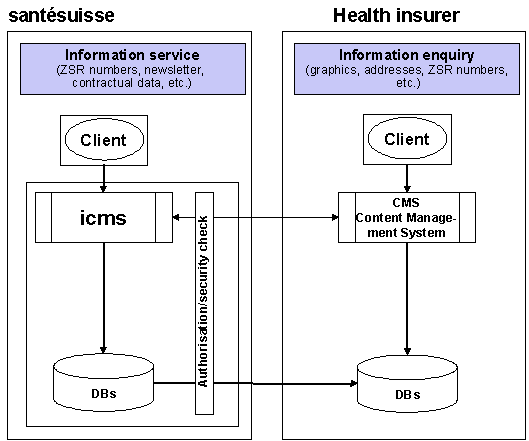
Fig. 3.1: Integration solution of santésuisse (overview)
Business perspective:
Prior to the launch of the E-Business solution, information was still supplied to members and interested parties by telephone, fax or post, so that each individual contact occurred directly via santésuiss (at that time still KSK). With the gradual outsourcing of data and information to the extranet and the internet within the scope of the E-Business integration, the direct contact interfaces could be drastically reduced (cf. Fig. 3.2). The data flow now takes place via the main part of the integration solution, namely the web platform.
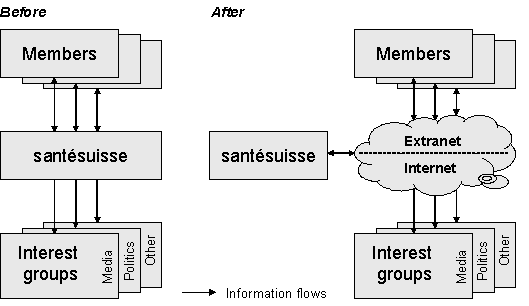
Fig. 3.2: Information interfaces before and after E-Business integration from the point of view of santésuisse
Process view:
The process view (information service of santésuisse; cf. Fig. 3.1) is shown in more detail below using the example of the newsletter and the provision of numbers in the payment office register – two selected main services. These two services were extensively expanded in the extranet with the relaunch of the santésuisse web platform in 2001. The data and information which is available here is mainly geared to the approximately 12,000 employees of Swiss health insurance companies and are indispensible for their daily work.
Newsletter
Above all in the area of the newsletter, the system was converted from the traditional internet pull approach to a push concept, i.e. so that santésuisse can inform its members daily (or several times a day) by e-mail about new information or newsletters. By activating the hyperlinks given in the e-mail, members can access the stated newsletter in the database. An authorisation concept controls forwarding of the e-mail, so that only members who also want to receive newsletters are informed about new editions. This approach also ensures that the newsletter remains of topical relevant for longer, since the documents stored in the database can be modified at any time, whilst the link remains unchanged.
While the newsletters were still sent out by post parallel to the electronic publication in a brief transitional period, distribution has been carried out exclusively via the extranet since 1.1.2002. By means of a headword search, the user can also search the newsletter database for the required contents. In addition to the costs savings by dispensing with postage costs on the part of santésuisse, the archiving costs for members could be reduced. Ultimately, by guaranteeing access to the database at all times, additional filing of newsletters at members’ offices became superfluous. Furthermore, members can individual configure which newsletters (e.g. from which canton) they want to subscribe to. Obligatory newsletters, by contrast, are always sent to each member, so that a “minimum supply” of information is guaranteed. Through the possibility of the newletter subscription, the danger of flooding users with information was minimised, that is, each member receives the information they require and is spared from superfluous information.
ZSR numbers subscription
The second main service provided by santésuisse is the provision of numbers in the payment office register. These numbers are required by the insurers for their electronic payment transactions with service providers (doctors, hospitals, etc.) and can be called up in the santésuisse extranet. This service is a subscription service where each subscriber can stipulate the volume, the geographical selection, the subscription interval and the format of data themselves. The thus configured data is periodically processed for the subscriber and made available for downloading (via extranet or via FTP). By outsourcing this service to santésuisse, mutations of data can be traced immediately and checked. Since the beginning of 2003, all health insurers procure the data which they need for processing electronic payment transactions with service providers from the santésuisse web platform.
The mask of the ZSR subscription administration allows varying entries or amendments depending on the user’s authority. This defined authorisation concept makes it possible to guarantee varying access to extranet data, depending on the user or user group, and to thus coordinate the required information supply.
Application view:
As far as the application aspect is concerned, the focus is on individual functions or modules of the icm application server (cf. Fig. 3.3). In order to be able to provide a complete CMS solution, at least the icms::content module (personalisation, time-controlled contents, work flow management, etc.) and icms::navigation module (implements dynamic, personalised content structures) are necessary. The solution can also be extended to include additional modules (e.g. icms::map for implementing an interacive place/site plan). Within santésuisse, modules such as icms::personalizer (for personalised processing of extranet pages), icms::interface (connection of external data sources), icms::faq (used for the publication and maintenance of FAQs) and icms::commerce (for implementing an individual web shop) are also used.
Solution architecture:
In order to technically implement the portal concept, a flexible and modularly extendable solution was sought, which should also take into account the tight financial resources (cf. Fig. 3.3). Against this background, the parties agreed on the inclusion of open source technologies. With insign GmbH, a partner could be gained which specialised in this area and offers an open application platform with its content management system solution icms (insign content management system). This allows santésuisse to extend or change the working tools provided in the web flexibly. In addition to the functionalities of a traditional content management system, this application platform also makes it possible to connect complex, external databases and to build up user-friendly services in a modular way.
The core of this solution icms is formed by the icms application server (IAS), which is located in a data center in Zurich. This carries out the central control of all applications and processes. The data is provided by the individual modules (e.g. icms::content) in templates and compiled by the parser integrated in the IAS depending on the authorisation of the respective user. The issued data is presented in HTML (or PDF) and can therefore be read by any standard browser. Other formats (XML, WML) can also be provided. santésuisse uses Linus as the operating system for the use of icms and the fast and stable database MySQL is used as the data source.
The integration of the web platform in the intranet of individual health insurers is shown below. At data level, the insurer’s databases can be synchronised with the databases of santésuisse via ODBC. For example, the data of the insurer’s contract database can be adjusted overnight, so that its CMS can access up-to-date contractual data at any time. At application level, integration takes place via “XML roundtrip”. This means that, for example, enquiries by the insurer are directed to the application server of santésuisse within their CMS (e.g. search for the address data of a doctor, etc) and this in turn returns the search result to the insurer’s CMS. Only a data exchange takes place in this case. At presentation level, the link between santésuisse and the health insurers is such that both the data and the layout of the health insurer’s intranet are procured from santésuisse.
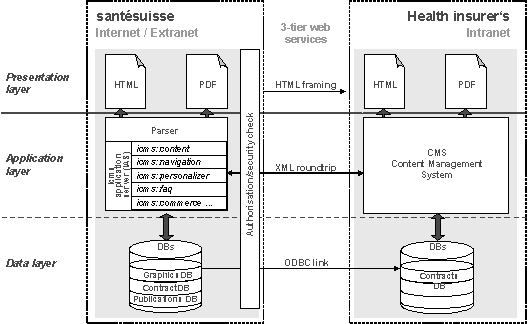
Fig. 3.3: Integration solution of santésuisse
4. Implementation
In an organisational sense, the E-Business strategy falls under the responsibility of the politics and communication department (APK), which has also pushed forwarded the integration of the solution. In addition to the department head of the APK department, only one other person (editor/webmaster of santésuisse) from santésuisse was involved in the project. This team was supported by a consultant who was hired to implement the required aspects, so that the solution could be pushed forward mainly in a close circle of three people.
In the first quarter of 2001, the first release of the new homepage was launched with access to the extranet. In the second half-year of 2001 connection to the contract database was carried out, which was made accessible using a log-in via extranet. In this database, members can view individual contracts with hospitals or doctors. In addition, the whole administration of the contract database is processed online. At the beginning of 2002, the graphics/statistics database was integrated, newsletter distribution was optimised and the newletter service was added. In the second half of 2002, the complete version of the ZSR and its subcription management could then be integrated via the extranet. The constant revision of the homepagte led to a second release in the first half of 2003, which is also designed to take into account the requirements of the user.
5. Operation
Maintenance:
Carpathia Consulting GmbH is responsible for operation of the solution. Tasks in the technical field are delegated to insign GmbH, which carries out updates and adjustments on the web platform and looks after and maintains the santésuisse web server.
Costs, benefits and profitability:
The main running costs for the solution consist of technical support of the web server by insign GmbH, which come to approximately CHF 1,000 per month. The management of contents, structure and user authorisations can be dealt with by the integrated CMS directly by santésuisse.
One-off investments incurring costs are above all the milestones achieved in the respective project phases (cf. Fig. 5.1). In addition to the first release of the homepage with extranet (approx. CHF 130,000), the integration of ZSR (approx. CHF 90,000) represents the second-largest cost block. As this amount, however, corresponds roughly to what had to be paid up to now for the maintenance of the ZSR to the third-party company (annually approxl CHF 80,000) this investment has already paid for itself.
With a total volume of approximately CHF 390,000 (minus the savings for ZSR of approx. CHF 310,000) for the E-Business solution over three years, the association was able to provide its members and interested parties with a flexible and efficient platform to support their work. The annual further developmenet costs of approx. CHF 100,000 are not too extortionate and do not arouse the feeling amongst members that their subscriptions are being wasted. Another factor is that the high costs incurred by sending the newsletter by letter post (approximately 10-15 letters per day) disappear.
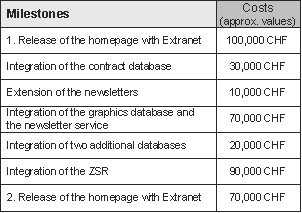
Fig. 5.1: Costs of the E-Business solution
6. Success factors and difficulties
According to those people involved, no major problems occurred during the launch of the E-Business solution. Due to the excellent personnel structure, the launch was received positively in the main and with curiosity within santésuisse and also by the health insurers. The conversion from “print media” to e-mail and the associated registration proceses only caused readjustment problems at a few especially small health insurers.
The reasons why the process ran so smoothly are, on the one hand, attributable to the excellent internal preparations. Thus, realistic scenarios were prepared in advance of the integration, which also took into account the limited budget. On the other hand, the employees and health insurers were integrated into the solution structure, so that the majority of users’ requirements could be taken into consideration. The specification of clear decisioni-making competencies and the always open and fair communication between the project partners also represented an important success factor.
Last but not least, the success of the E-Business solution is also due to the core function of the association. The guarantee of the supply of information is made considerably easier through the availability of graphics, statistics or publications (eg. newsletters) via extranet or through support when processing payment transactions with service providers by means of ZSR.
Conclusion
The santésuisse case study occupies a position of speciasl importance in the subject of the integration of E-Business solutions due to the unusual positioning of the association. It shows that E-Business does not just appear to make sense in the field of profit-oriented companies, but that an application in the field of non-proft organisations can also play a substantial role. With the case study it could be demonstrated how the work flows in the associations could be accelerated and the supply of information to members and interested parties could be guarnteed in a targeted way. In addition, the case is an example of the fact that not only internal structures can be changed through the introduction of E-Business, but that an image transformation can also take place.





